Bicarbonate-buffered solutions
Prescribe flexibly with our wide range of bicarbonate-buffered solutions indicated for CRRT
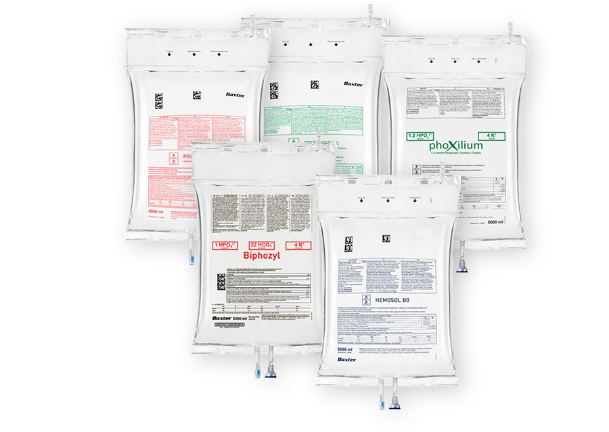
With one of the largest portfolios of CRRT solutions, we offer a range of bicarbonate-buffered solutions, with and without phosphate, containing various concentrations of key electrolytes, to meet the diverse clinical needs of both adult and pediatric patients.1-5
How can our bicarbonate-buffered solutions help treat your patients?

Phosphate-containing solutions
We offer the only phosphate-containing CRRT solutions indicated as dialysate and replacement fluid.1,2,13

Simplified therapy delivery
Approved for both diffusive and convective therapies,1-5 our CRRT solutions with color-coded labeling are designed for ease-of-use, helping simplify therapy delivery.

Improved efficiency
Premixed CRRT solutions help reduce the risk of preparation errors and related potential liability of pharmacy-made solutions while helping improve clinical and cost efficiencies.8-10
"Our CRRT solutions were used in multiple landmark studies – the VA/NIH ATN study (n=1124) and RENAL study (n=1508) – without any reports of complications related to the solutions.”11,12

Frontrunner in purposefully designed CRRT solutions
Meet the diverse treatment requirements of your patients, be it adults or children,1-5 using our extensive range of CRRT solutions. Minimize the risk of preparation errors associated with pharmacy-made solutions and increase efficiency8-10 with our premixed dialysis and replacement solutions for on-label delivery of CRRT.1-5 And treat more flexibly with a wide portfolio of formulations that includes both phosphate-containing and phosphate-free solutions, with and without calcium. Our range of CRRT solutions contain various potassium, phosphate, calcium, glucose, and bicarbonate concentrations.

Bicarbonate-buffered solutions with phosphate
Reduce the incidence of hypophosphatemia using our unique bicarbonate-buffered dialysis and replacement solution with phosphate.13-16 Treatment-induced electrolyte disorders are a challenge for patients being administered CRRT over a prolonged period.16,21 Reduce this complication as well as additional nursing burden of supplementing phosphate with our phosphate-containing solutions, which are indicated for use as replacement solutions.1,2,8,9,22,23
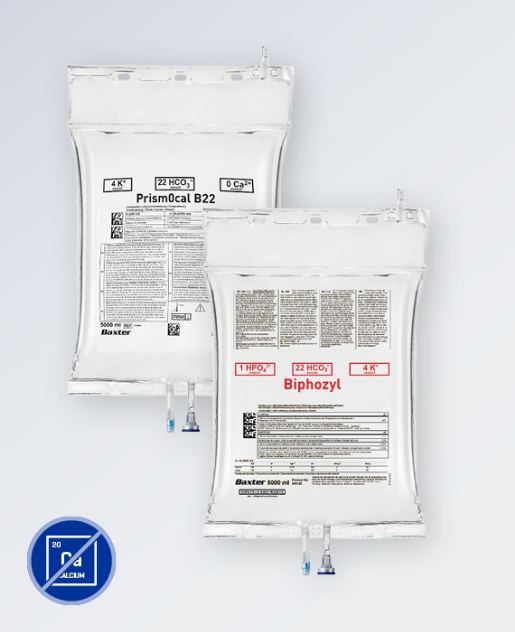
Calcium-free solutions for RCA
Achieve flexibility in treatment with our selection of calcium-free, bicarbonate-buffered solutions designed for Regional Citrate Anticoagulation (RCA).1,24 Calcium-free dialysis and replacement solutions are used during citrate anticoagulation to avoid antagonism of the anticoagulation. With these formulations, you have a choice of simplified protocols in both diffusive and convective therapies.6,7
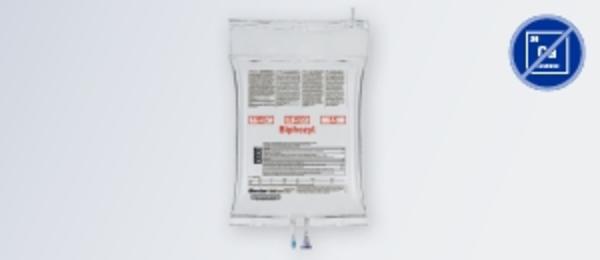
Biphozyl
Bicarbonate-buffered solution for hemodialysis and hemofiltration.

Phoxilium
Bicarbonate-buffered solution for hemodialysis and hemofiltration.
Bicarbonate-buffered solutions without phosphate
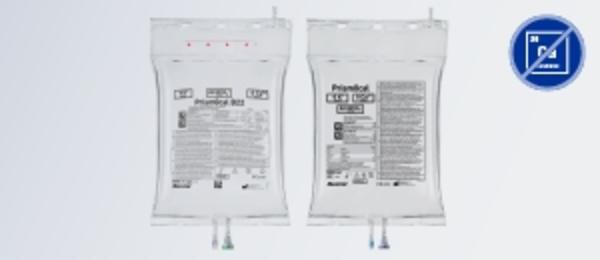
Prism0cal range
Bicarbonate-buffered dialysis solutions for CRRT.

Hemosol B0
Bicarbonate-buffered solution for hemodialysis and hemofiltration.
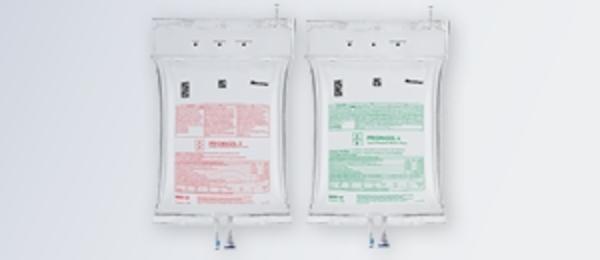
Prismasol 2&4
Bicarbonate-buffered solutions for hemodialysis and hemofiltration.
For safe and proper use of the products mentioned herein, please refer to the Instructions for Use.
IMPORTANT SAFETY INFORMATION
This abbreviated summary of product characteristics (SPC) is intended for international use. Please note that it may differ from the licensed SPC in the country where you are practicing. Therefore, always consult your country-specific SPC or package leaflet.
NAME OF THE MEDICINAL PRODUCT
Biphozyl solution for haemodialysis/haemofiltration
QUALITATIVE AND QUANTITATIVE COMPOSITION
Biphozyl is presented in a two-compartment bag. The final reconstituted solution is obtained after opening the peel seal and mixing the contents of the two compartments.
|
BEFORE RECONSTITUTION |
|
|
|
Composition in the small compartment: |
|
|
|
Magnesium chloride hexahydrate |
3.05 g/l |
|
|
Composition in the large compartment: |
|
|
|
Sodium chloride |
7.01 g/l |
|
|
Sodium hydrogen carbonate |
2.12 g/l |
|
|
Potassium chloride |
0.314 g/l |
|
|
Disodium phosphate dihydrate |
0.187 g/l |
|
AFTER RECONSTITUTION |
|
|
|
|
Composition of the reconstituted solution: |
|
|
|
|
|
|
mmol/l |
mEq/l |
|
Sodium |
Na+ |
140 |
140 |
|
Potassium |
K+ |
4 |
4 |
|
Magnesium |
Mg2+ |
0.75 |
1.5 |
|
Chloride |
Cl- |
122 |
122 |
|
Hydrogen phosphate |
HPO42- |
1 |
2 |
|
Hydrogen carbonate |
HCO3- |
22 |
22 |
|
Theoretical osmolarity: 290 mOsm/l pH ≈ 7.0-8.0 For the full list of excipients, see the full SPC. |
|
|
|
CLINICAL PARTICULARS
THERAPEUTIC INDICATIONS
Biphozyl is used as replacement solution and as dialysate for treatment of acute kidney injury during continuous renal replacement therapy (CRRT). Biphozyl is used in a post-acute phase after initiation of renal replacement therapy when pH, potassium and phosphate concentration have returned to normal. Biphozyl is also used when other buffer sources are available as well as during regional citrate anticoagulation. Moreover, Biphozyl is used in patients with hypercalcaemia. Biphozyl may also be used in cases of drug poisoning or intoxications when the substances are dialysable or filterable.
CONTRAINDICATIONS
Hypersensitivity to the active substance(s) or to any of the excipients listed in section 6.1 of the full SPC.
Hypocalcaemia unless calcium is provided to the patient by other sources.
Hyperkalaemia.
Hyperphosphataemia.
SPECIAL WARNINGS AND PRECAUTIONS FOR USE
The solution should be used only by, or under the direction of a physician competent in CRRT treatments using haemofiltration, haemodiafiltration and haemodialysis.
Warnings:
Biphozyl should not be used in patients with hyperkalaemia (see section 4.3 of the full SPC). The serum potassium concentration must be monitored before and during haemofiltration and/or haemodialysis.
Because Biphozyl is a potassium-containing solution, hyperkalaemia may occur transiently after treatment is initiated. Decrease the infusion rate and confirm that the desired potassium concentration is achieved. If hyperkalaemia does not resolve, stop administration promptly.
If hyperkalaemia develops when Biphozyl is used as dialysate, administration of a potassium-free dialysate may be necessary to increase the rate of potassium removal.
Because Biphozyl is a phosphate-containing solution, hyperphosphataemia may occur transiently after treatment is initiated. Decrease the infusion rate and confirm that the desired phosphate concentration is achieved. If hyperphosphataemia does not resolve, stop administration promptly (see section 4.3 of the full SPC).
Electrolyte and blood acid-base parameters should be monitored regularly in patients treated with Biphozyl. Biphozyl contains hydrogen phosphate, a weak acid that can influence the patient’s acid-base balance. If metabolic acidosis develops or worsens during therapy with Biphozyl, the infusion rate may need to be decreased or its administration stopped.
Because Biphozyl contains no glucose, administration may lead to hypoglycaemia. Blood glucose levels should be monitored regularly in diabetic patients (including careful consideration of patients receiving insulin or other glucose lowering medications), but also considered in non-diabetic patients, e.g. risk for silent hypoglycemia during the procedure. If hypoglycaemia develops, use of a glucose-containing solution should be considered. Other corrective measures may be necessary to maintain desired glycaemic control.
The Instructions for Use (see section 6.6 of the full SPC) must be strictly followed. The solutions in the two compartments must be mixed before use. Use of a contaminated solution may cause sepsis and shock. Use only with an appropriate extracorporal renal replacement equipment.
Special precautions for use:
Biphozyl is calcium free and could cause hypocalcaemia (see section 4.8 of the full SPC). Infusion of calcium might be necessary.
Biphozyl may be warmed to 37°C to enhance patient comfort. Warming of the solution prior to use should be done before reconstitution with dry heat only. Solutions should not be heated in water or in a microwave oven. Biphozyl should be inspected visually for particulate matter and discoloration prior to administration, whenever solution and container permit. Do not administer unless the solution is clear and the seal is intact.
Haemodynamic status, fluid balance, electrolyte and acid-base balance should be closely monitored throughout the procedure including all fluid inputs and outputs, even those not directly related to CRRT. The content of hydrogen carbonate in Biphozyl is at the lower end of the normal range for blood concentration. Biphozyl is appropriate when using citrate anticoagulation, as citrate is metabolised to hydrogen carbonate, or when CRRT has been able to restore normal pH values. Assessment of buffer needs through measurement of repeated blood acid/base parameters and review of the overall therapy is mandatory. A solution with higher hydrogen carbonate content may be required.
In case of hypervolaemia, the net ultrafiltration rate prescribed for the CRRT device can be increased and/or the rate of administration of solutions other than replacement fluid and/or dialysate can be reduced.
In case of hypovolaemia, the net ultrafiltration rate prescribed for the CRRT device can be reduced and/or the rate of administration of solutions other than replacement fluid and/or dialysate can be increased. (see section 4.9 of the full SPC).
For general therapy related precautions/contraindications see section 4.3 of the full SPC.
FERTILITY, PREGNANCY AND LACTATION
Fertility: no effects on fertility are anticipated, since sodium, potassium, magnesium, chloride, hydrogen phosphate and hydrogen carbonate are normal constituents of the body.
Pregnancy and lactation: there are no documented clinical data on the use of Biphozyl during pregnancy and lactation. Biphozyl should only be administered to pregnant and lactating women if clearly needed.
UNDESIRABLE EFFECTS
Undesirable effects can result from the Biphozyl solution used or the dialysis treatment. The following undesirable effects are reported from post-marketing experience. Hydrogen carbonate-buffered haemofiltration and haemodialysis solutions are generally well tolerated.
Undesirable effects related to the solution:
• Undesirable effects are (frequency not known): electrolyte imbalances (e.g., hypocalcaemia, hyperkalaemia, hyperphosphataemia), acid-base balance disorders (e.g., metabolic acidosis).
Undesirable effects related generally to the dialysis treatment:
• Undesirable effects are (frequency not known): fluid imbalance (e.g., hypervolaemia, hypovolaemia), hypotension, nausea, vomiting, muscle cramps.
Reporting suspected adverse reactions after authorisation of the medicinal product is important. It allows continued monitoring of the benefit/risk balance of the medicinal product. Healthcare professionals are asked to report any suspected adverse reactions via their national reporting system.
For posology, incompatibilities, interactions, overdose, pharmacological properties and pharmaceutical particulars, please refer to the full SPC.
Medicinal product subject to medical prescription.
June 2018
NAME OF THE MEDICINAL PRODUCT
Phoxilium 1.2 mmol/l phosphate solution for haemodialysis/haemofiltration
QUALITATIVE AND QUANTITATIVE COMPOSITION
Phoxilium is presented in a two-compartment bag. The final reconstituted solution is obtained after breaking the peel seal and mixing both solutions.
|
BEFORE RECONSTITUTION |
|
|
|
1000 ml of solution in the small compartment (A) contains: |
|
|
|
Calcium chloride, 2H2O |
3.68 g |
|
|
Magnesium chloride, 6H2O |
2.44 g |
|
|
1000 ml of solution in the large compartment (B) contains: |
|
|
|
Sodium chloride |
6.44 g |
|
|
Sodium hydrogen carbonate |
2.92 g |
|
|
Potassium chloride |
0.314 g |
|
|
Disodium phosphate, 2H2O |
0.225 g |
|
AFTER RECONSTITUTION |
|
|
|
|
1000 ml of the reconstituted solution contains: |
|
|
|
|
|
|
mmol/l |
mEq/l |
|
Calcium |
Ca2+ |
1.25 |
2.50 |
|
Magnesium |
Mg2+ |
0.600 |
1.20 |
|
Sodium |
Na+ |
140.0 |
140.0 |
|
Chloride |
Cl- |
115.9 |
115.9 |
|
Hydrogen phosphate |
HPO42- |
1.20 |
2.40 |
|
Hydrogen carbonate |
HCO3- |
30.0 |
30.0 |
|
Potassium |
K+ |
4.00 |
4.00 |
|
Each 1000 ml of the final reconstituted solution corresponds Theoretical osmolarity: 293 mOsm/l For the full list of excipients, see the full SPC. |
|
|
|
CLINICAL PARTICULARS
THERAPEUTIC INDICATIONS
Phoxilium is used for CRRT (continuous renal replacement therapy) in critically ill patients with ARF (acute renal failure) when pH and kalaemia have been restored to normal and when the patients need phosphate supplementation for loss of phosphate in the ultrafiltrate or to the dialysate during CRRT.
Phoxilium may also be used in cases of drug poisoning or intoxications when the poisons are dialysable or pass through the membrane.
Phoxilium is indicated for use in patients with normal kalaemia and normal or hypophosphataemia.
CONTRAINDICATIONS
Hypersensitivity to the active substance(s) or to any of the excipients listed in section 6.1 of the full SPC. Solution dependent contraindications
• Hyperkalaemia
• Metabolic alkalosis
• Hyperphosphataemia
Haemofiltration/- dialysis dependent contraindications
• Renal failure with pronounced hypercatabolism, if the uraemic symptoms cannot be corrected with haemofiltration or haemodiafiltration
• Insufficient arterial pressure in the vascular access
• Systemic anticoagulation if there is a high risk of haemorrhage
SPECIAL WARNINGS AND PRECAUTIONS FOR USE
The solution shall be used only by, or under the direction of, a physician competent in CRRT treatments using haemofiltration, haemodiafiltration and haemodialysis.
Warnings:
Phoxilium should not be used in patients with hyperkalaemia (see section Contraindications). The serum potassium concentration must be monitored before and during haemofiltration and/or haemodialysis.
Because Phoxilium is a potassium-containing solution, hyperkalaemia may occur transiently after treatment is initiated. Decrease the infusion rate and confirm that the desired potassium concentration is achieved. If hyperkalaemia does not resolve, stop administration promptly.
If hyperkalaemia develops when Phoxilium is used as a dialysate, administration of a potassium-free dialysate may be necessary to increase the rate of potassium removal.
Because Phoxilium is a phosphate-containing solution, hyperphosphataemia may occur transiently after treatment is initiated. Decrease the infusion rate and confirm that the desired phosphate concentration is achieved. If hyperphosphataemia does not resolve, stop administration promptly (see section Contraindications).
Electrolyte and blood acid/base parameters should be monitored regularly in patients treated with Phoxilium. Phoxilium contains hydrogen phosphate, a weak acid that can influence the patient’s acid/base balance. If metabolic acidosis develops or worsens during therapy with Phoxilium, the infusion rate may need to be decreased or its administration stopped.
Because Phoxilium contains no glucose, administration may lead to hypoglycaemia. Blood glucose levels should be monitored regularly in diabetic patients (including careful consideration of patients receiving insulin or other glucose lowering medications), but also considered in non-diabetic patients, e.g. risk for silent hypoglycaemia during the procedure. If hypoglycaemia develops, use of a glucose-containing solution should be considered. Other corrective measures may be necessary to maintain desired glycaemic control.
The Instructions for Use (see section 6.6 of the full SPC) must be strictly followed. The solutions in the two compartments must be mixed before use. Use of a contaminated solution may cause sepsis or shock.
Do not administer the solution unless it is clear. Aseptic technique must be used during connection / disconnection of the line sets to the Phoxilium container.
Use only with an appropriate extracorporal renal replacement equipment.
Special precautions for use:
Phoxilium may be warmed to 37°C to enhance patient comfort. Warming of the solution prior to use should be done before reconstitution with dry heat only. Solutions should not be heated in water or in a microwave oven. Phoxilium should be inspected visually for particulate matter and discoloration prior to administration, whenever solution and container permit. Do not administer unless the solution is clear and the seal is intact.
Haemodynamic status, fluid balance, electrolyte and acid-base balance shall be closely monitored throughout the procedure including all fluid inputs and outputs, even those not directly related to CRRT.
In case of hypervolaemia, the net ultrafiltration rate prescribed for the CRRT device can be increased and/or the rate of administration of solutions other than replacement fluid and/or dialysate can be reduced. In case of hypovolaemia, the net ultrafiltration rate prescribed for the CRRT device can be reduced and/or the rate of administration of solutions other than replacement fluid and/or dialysate can be increased.
FERTILITY, PREGNANCY AND LACTATION
Fertility: No effects on fertility are anticipated, since calcium, sodium, potassium, magnesium, chloride, hydrogen phosphate and hydrogen carbonate are normal constituents of the body. Pregnancy and lactation: There are no documented clinical data on the use of Phoxilium during pregnancy and lactation. Phoxilium should only be administered to pregnant and lactating women if clearly needed.
UNDESIRABLE EFFECTS
Undesirable effects can result from the solution used or the treatment.
Bicarbonate-buffered haemofiltration and haemodialysis solutions are generally well tolerated.
The following undesirable effects have been reported from post-marketing experience.
Undesirable effects related to the solution:
• Undesirable effects are (frequency not known): electrolyte imbalances (e.g., hyperphosphataemia), fluid imbalance (e.g., hypervolaemia, hypovolaemia), acid-base balance disorders (e.g., metabolic acidosis, metabolic alkalosis).
Undesirable effects related to the dialysis treatment:
• Undesirable effects are (frequency not known): hypotension, nausea, vomiting, muscle cramps.
Reporting suspected adverse reactions after authorisation of the medicinal product is important. It allows continued monitoring of the benefit/risk balance of the medicinal product. Healthcare professionals are asked to report any suspected adverse reactions via their national reporting system.
For posology, incompatibilities, interactions, overdose, pharmacological properties and pharmaceutical particulars, please refer to the full SPC.
Medicinal product subject to medical prescription.
October 2018
NAME OF THE MEDICINAL PRODUCT
Hemosol B0 solutions for haemodialysis/haemofiltration
QUALITATIVE AND QUANTITATIVE COMPOSITION
Hemosol B0 consists of a two compartment polyolefin bag containing the electrolyte solutions in the small compartment (compartment A) and the buffer solution in the large compartment (compartment B).
|
BEFORE RECONSTITUTION |
|
|
1000 ml of electrolyte solution small compartment (A) contains:
|
|
|
Active substances: |
|
|
Calcium chloride, 2H2O |
5.145 g |
|
Magnesium chloride, 6H2O |
2.033 g |
|
Lactic acid |
5.4 g |
|
1000 ml of buffer solution large compartment (B) contains: |
|
|
Active substances: |
|
|
Sodium hydrogen carbonate |
3.09 g |
|
Sodium chloride |
6.45 g |
|
AFTER RECONSTITUTION |
|
|
|
|
The small and the large compartments are |
|
|
|
|
|
|
mmol/l |
mEq/l |
|
Calcium |
Ca2+ |
1.75 |
3.50 |
|
Magnesium |
Mg2+ |
0.5 |
1.0 |
|
Sodium |
Na+ |
140 |
140 |
|
Chloride |
Cl- |
109.5 |
109.5 |
|
Hydrogen carbonate |
HCO3- |
32 |
32 |
|
Lactate |
C3H5O3- |
3 |
3 |
|
Theoretical osmolarity: 287 mOsm/l For the full list of excipients, see the full SPC. |
|
|
|
CLINICAL PARTICULARS
THERAPEUTIC INDICATIONS
As substitution solution in continuous haemofiltration and haemodiafiltration and as dialysis solution in continuous haemodialysis for acute renal failure in adult and children of all ages.
CONTRAINDICATIONS
Hypersensitivity to the active substances or to any of the excipients listed in section 6.1 of the full SPC.
SPECIAL WARNINGS AND PRECAUTIONS FOR USE
Warnings:
The substitution solution Hemosol B0 is potassium-free. The serum potassium concentration must be monitored before and during hemofiltration and/or hemodialysis.
The electrolyte solution must be mixed with the buffer solution before use to obtain the final solution suitable for haemofiltration/haemodiafiltration/continuous haemodialysis.
Use only with appropriate extracorporeal renal replacement equipment. Because the solution contains no glucose, administration may lead to hypoglycemia. Blood glucose levels should be monitored regularly.
Hemosol B0 contains hydrogen carbonate (bicarbonate), and lactate (a hydrogen carbonate precursor) which can influence the patient’s acid-base balance. If metabolic alkalosis develops or worsens during therapy with the solution, the administration rate may need to be decreased, or the administration stopped.
The use of contaminated haemofiltration solution may cause sepsis, shock and fatal conditions.
Precautions for use:
Hemosol B0 may be warmed to 37°C to enhance patient comfort. Warming of the solution prior to use should be done before reconstitution with dry heat only. Solutions should not be heated in water or in a microwave oven. The solution should be inspected visually for particulate matter and discoloration prior to administration, whenever solution and container permit. Do not administer unless the solution is clear and the seal is intact.
Before and during treatment, electrolyte and acid-base balance should be closely monitored throughout the procedure. Phosphate up to 1.2 mmol/l may be added to the solution. If potassium phosphate is added, the total potassium concentration should not exceed 4 mEq/l (4 mmol/l). Potassium supplement might be necessary.
The patient’s hemodynamic status and fluid balance should be monitored throughout the procedure and corrected as needed.
Paediatric population:
There are no specific warnings and precautions when using this medicine for children.
FERTILITY, PREGNANCY AND LACTATION
Pregnancy and breastfeeding:
No effects during pregnancy or on the breast-fed newborn/infant are anticipated. There is no report on Hemosol B0 during pregnancy or lactation but literature on renal replacement therapy during acute kidney injury does not suggest risks associated with solutions. The prescriber should consider the benefit/risk relationship before administering Hemosol B0 to pregnant or breast feeding women.
Fertility:
There are no clinical data on fertility. However, no effects on fertility are anticipated.
UNDESIRABLE EFFECTS
The following undesirable effects are reported from post-marketing experience.
Undesirable effects are (frequency unknown): electrolyte imbalances (e.g., hypophosphataemia, hypokalaemia), acid-base balance disorders, fluid imbalance, hypotension, nausea, vomiting, muscle spasms.
Special attention must be taken for patients with hypokalaemia as this solution is potassium-free (see section 4.4 of the full SPC).
Reporting suspected adverse reactions after authorisation of the medicinal product is important. It allows continued monitoring of the benefit/risk balance of the medicinal product. Healthcare professionals are asked to report any suspected adverse reactions via their national reporting system.
For posology, incompatibilities, interactions, overdosage, pharmacological properties and pharmaceutical particulars, please refer to the full SPC.
Medicinal product subject to medical prescription.
July 2018
NAME OF THE MEDICINAL PRODUCT
Prismasol 2 mmol/l Potassium solution for haemodialysis/haemofiltration.
Prismasol 4 mmol/l Potassium solution for haemodialysis/haemofiltration.
QUALITATIVE AND QUANTITATIVE COMPOSITION
Prismasol 2 and 4 mmol/l Potassium are presented in a two-compartment bag containing in the smaller compartment A, the electrolyte solution, and in the larger compartment B, the buffer solution. The final reconstituted solution is obtained after breaking the peel seal and mixing both solutions.
|
BEFORE RECONSTITUTION |
|
|
|
1000 ml of electrolyte solution (small compartment A) contains: |
|
|
|
Active substances: |
Prismasol 2 |
Prismasol 4 |
|
Calcium chloride dihydrate |
5.145 g |
5.145 g |
|
Magnesium chloride hexahydrate |
2.033 g |
2.033 g |
|
Glucose anhydrous (as glucose monohydrate) |
22.00 g |
22.00 g |
|
(S)-Lactic acid (as lactic acid solution 90%w/w) |
5.400 g |
5.400 g |
|
1000 ml of electrolyte solution (large compartment B) contains: |
|
|
|
Active substances: |
Prismasol 2 |
Prismasol 4 |
|
Sodium chloride |
6.45 g |
6.45 g |
|
Potassium chloride |
0.157 g |
0.314 g |
|
Sodium hydrogen carbonate |
3.090 g |
3.090 g |
|
AFTER RECONSTITUTION |
|
|
|
|
|
|
1000 ml of the reconstituted solution contains:
|
|
|
|
|
|
|
|
|
Prismasol 2 |
Prismasol 2 |
Prismasol 4 |
Prismasol 4 |
|
Calcium |
Ca2+ |
1.75 |
3.50 |
1.75 |
3.50 |
|
Magnesium |
Mg2+ |
0.5 |
1.0 |
0.5 |
1.0 |
|
Sodium |
Na+ |
140 |
140 |
140 |
140 |
|
Chloride |
Cl- |
111.5 |
111.5 |
113.5 |
113.5 |
|
Hydrogen carbonate |
HCO3- |
32 |
32 |
32 |
32 |
|
Lactate |
|
3 |
3 |
3 |
3 |
|
Potassium |
K+ |
2 |
2 |
4 |
4 |
|
Glucose |
|
6.1 |
|
6.1 |
|
|
Each litre of the final reconstituted Theoretical osmolarity: 297 mOsm/l pH of the reconstituted solution: 7.0-8.5 For the full list of excipients, see the full SPC. |
|
|
|
|
|
CLINICAL PARTICULARS
THERAPEUTIC INDICATIONS
Prismasol 2 and 4 mmol/l Potassium are used in the treatment of renal failure, as substitution solution in haemofiltration and haemodiafiltration and as dialysis solution in continuous haemodialysis or continuous haemodiafiltration.
Prismasol 2 and 4 mmol/l Potassium solutions may also be used in case of drug poisoning with dialysable or filterable substances.
Prismasol 2 mmol/l Potassium solution is indicated in patients who have tendency to hyperkalaemia.
Prismasol 4 mmol/l Potassium solution is indicated in patients who are normokalaemic.
CONTRAINDICATIONS
Prismasol 2 mmol/l Potassium: hypokalaemia; metabolic alkalosis.
Prismasol 4 mmol/l Potassium: hyperkalaemia; metabolic alkalosis.
Hypersensitivity to the active substances or to any of the excipients listed in section 6.1 of the full SPC.
SPECIAL WARNINGS AND PRECAUTIONS FOR USE
The solution should be used only by, or under the direction of a physician competent in renal failure treatments using haemofiltration, haemodiafiltration and continuous haemodialysis.
Warnings:
The electrolyte solution must be mixed with the buffer solution before use to obtain the reconstituted solution suitable for haemofiltration/haemodiafiltration/continuous haemodialysis.
Use only with appropriate extracorporeal renal replacement equipment.
The solution is a potassium-containing solution. The serum potassium concentration must be monitored before and during haemofiltration and/or haemodialysis.
Prismasol 2 mmol/l Potassium: depending on the serum potassium concentration before treatment, hypo- or hyperkalaemia may develop. If hypokalaemia occurs, addition of potassium and/or administration of a dialysate with higher potassium concentration may be necessary.
Prismasol 4 mmol/l Potassium: the solution should not be used in patients with hyperkalaemia.
Prismasol 2 and 4 mmol/l Potassium: if hyperkalaemia occurs after treatment is initiated, additional sources of potassium influencing blood concentrations should be assessed. When the solution is used as a replacement solution, decrease the infusion rate and confirm that the desired potassium concentration is achieved.
If hyperkalaemia does not resolve, stop the infusion promptly. If hyperkalaemia develops when the solution is used as a dialysate, administration of a potassium-free dialysate may be necessary to increase the rate of potassium removal. Despite no cases of severe corn hypersensitivity reactions being reported with Prismasol, solutions containing glucose derived from hydrolysed maize starch should not be used in patients with a known allergy to maize or maize products. The administration must be stopped immediately if any signs or symptoms of a suspected hypersensitivity reaction develop. Appropriate therapeutic countermeasures must be instituted as clinically indicated.
Because the solutions contain glucose and lactate hyperglycaemia may develop, especially in diabetic patients. Blood glucose levels should be monitored regularly. If hyperglycaemia develops, administration of glucose-free replacement solution/dialysate may be necessary. Other corrective measures may be needed to maintain desired glycaemic control. Prismasol 2 and 4 mmol/l Potassium contain hydrogen carbonate (bicarbonate), and lactate (a hydrogen carbonate precursor) which can influence the patient’s acid–base balance. If metabolic alkalosis develops or worsens during therapy with the solution, the administration rate may need to be decreased, or the administration stopped.
The use of contaminated haemofiltration and haemodialysis solution may cause sepsis, shock and death.
Special precautions for use:
Prismasol 2 and 4 mmol/l Potassium may be warmed to 37°C to enhance patient comfort. Warming of the solution prior to use should be done before reconstitution with dry heat only. Solutions should not be heated in water or in a microwave oven. The solution should be inspected visually for particulate matter and discoloration prior to administration, whenever solution and container permit. Do not administer unless the solution is clear and the seal is intact.
Before and during treatment, electrolyte and acid-base balance should be closely monitored throughout the procedure. Phosphate up to 1.2 mmol/l may be added to the solution. Prismasol 2 mmol/l potassium: if potassium phosphate is added, the total potassium concentration should not exceed 4 mEq/l (4 mmol/l). Prismasol 4 mmol/l potassium: use sodium phosphate if adding phosphate to the bag. Inorganic phosphate must be substituted in cases of hypophosphataemia. The patient’s haemodynamic status and fluid balance should be monitored throughout the procedure and corrected as needed.
Paediatric population:
There are no specific warnings and precautions when using this medicine for children.
FERTILITY, PREGNANCY AND LACTATION
Pregnancy and breastfeeding: there are no adequate data from the use of Prismasol 2 or 4 mmol/l Potassium in pregnant or lactating woman.
The prescriber should consider the benefit/risk relationship before administering Prismasol 2 or 4 mmol/l Potassium to a pregnant or breast-feeding woman.
Fertility: there are no data available on fertility.
UNDESIRABLE EFFECTS
The following undesirable effects are reported from post-marketing experience.
Undesirable effects are (frequency not known): electrolyte imbalances (e.g., hypokalaemia with Prismasol 2 mmol/l Potassium, hypophosphataemia), acid-base balance disorders (e.g., metabolic alkalosis), fluid imbalance (e.g., fluid retention, dehydration), hyperglycaemia, hypotension, nausea, vomiting, muscle spasms, calcium ionized increased with Prismasol 4 mmol/l Potassium.
Reporting suspected adverse reactions after authorisation of the medicinal product is important. It allows continued monitoring of the benefit/risk balance of the medicinal product. Healthcare professionals are asked to report any suspected adverse reactions via their national reporting system.
For posology, incompatibilities, interactions, overdose, pharmacological properties and pharmaceutical particulars, please refer to the full SPC.
Medicinal product subject to medical prescription.
March 2018